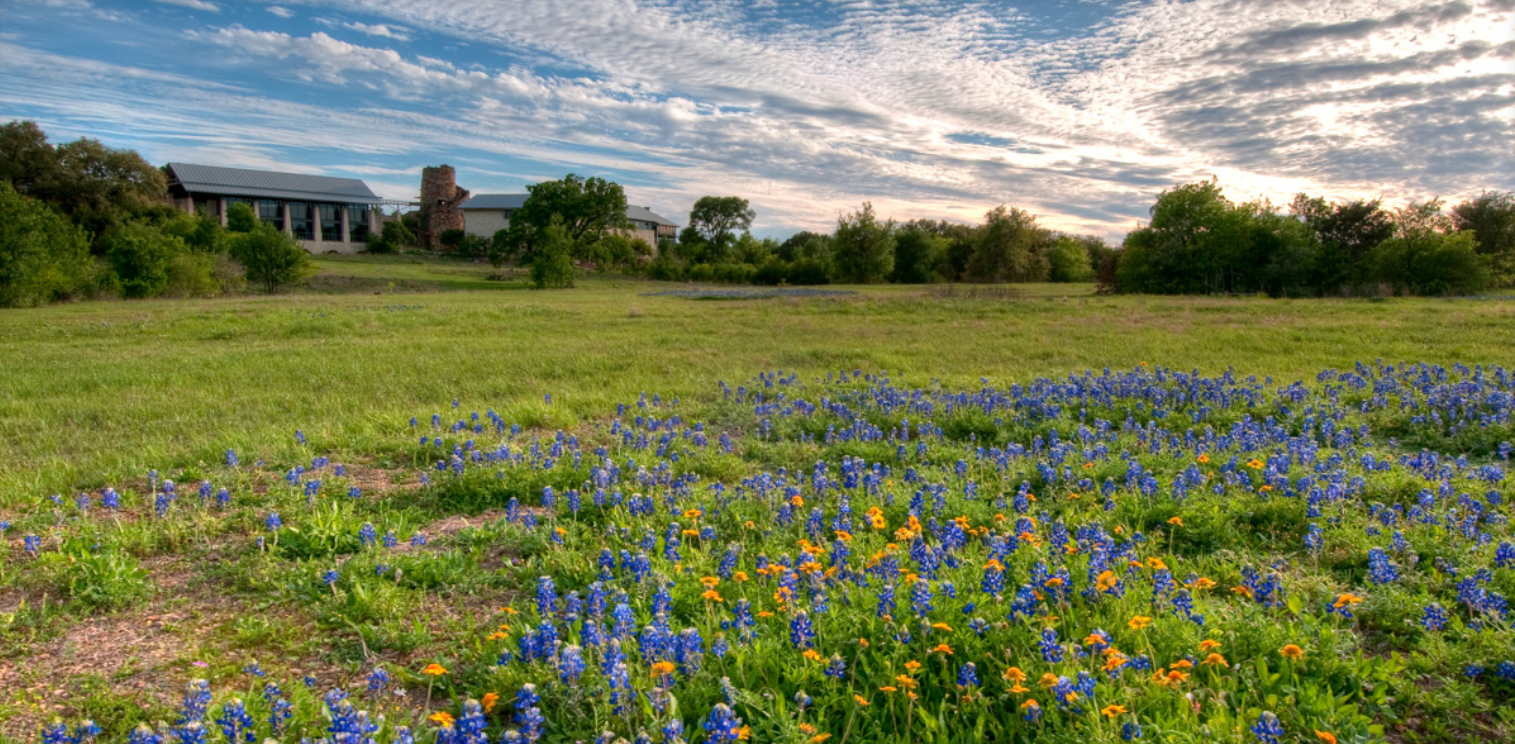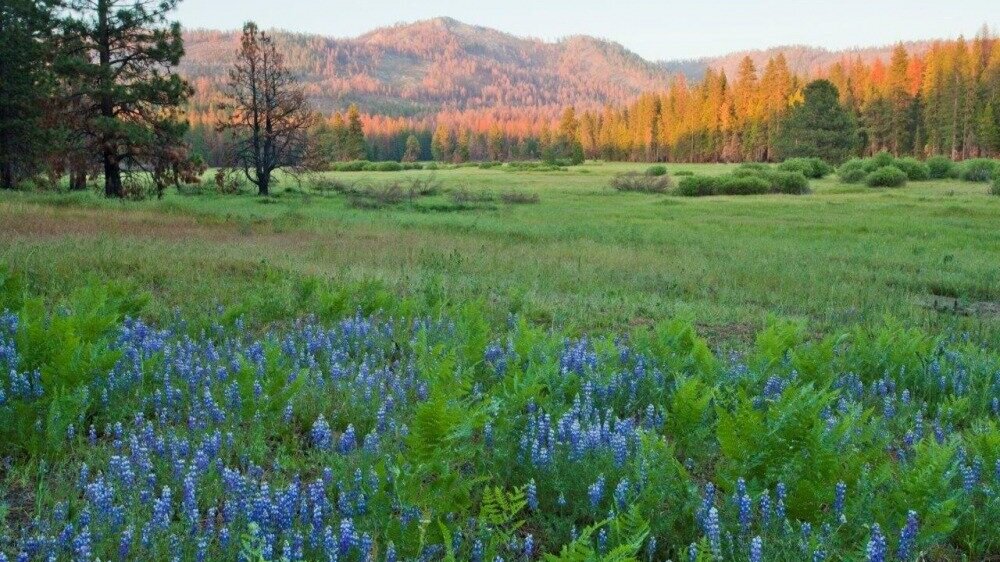4 popular American meadows
Across the United States, from central Texas to a river valley in Massachusetts to the Sierras in California to southern Wisconsin, meadows quietly do their work—supporting entire ecosystems of wildlife, pollinators, and perennial flowers and grasses. Wild meadows crop up in prairies and savannas in the wake of grazing animals and fires. They grow in the high plains where rainfall is light. They last for as long as the conditions that put them there do—in some instances for thousands of years.
The Lady Bird Johnson Wildflower Center offers labeled displays of wildflowers. Photo source: Lady Bird Johnson Wildflower Center
“For a wild meadow to survive, any or all of these inputs are needed to keep woody plants from overtaking the perennial grasses and wildflowers that make up meadows,” says Owen Wormser, author of Lawns into Meadows. In manmade meadows, he says, a single annual mowing mimics the effect those natural events cause by limiting woody growth that might try to move in.
The following meadows are among the country’s best known, and reflect varying degrees of human intervention and care. They range from wild ones, like those in California’s Yosemite Park, to meadows that have been cultivated or restored, like the ones at the Lady Bird Johnson Wildflower Center. You can support meadows by donating to restoration and pollinator projects, or by planting your own.
The Savanna Meadow Trail offers views of the native grasses, wildlife, and big sky - Photo source: Lady Bird Johnson Wildflower Center | The University of Texas at Austin
The Lady Bird Johnson Wildflower Center, University of Texas, Austin, FOUNDED IN 1982
Named after the First Lady praised for her environmental activism, the Lady Bird Johnson Wildflower Center covers 284 acres. It concentrates on growing and researching native plants, as well as on conservation and land management. Its Savanna Meadow Trail and Simmons Research Trail traverse native grasslands, where it’s possible to spot roadrunners and other wildlife. The Center also offers an online native plants database that allows you to research what’s native in your particular locale, or search for the name and origin of a plant you’ve spotted.
Arcadia’s All-Persons Trail offers an ADA-compliant path with features such as handrails and guide ropes, educational materials, and picnic seating areas- (Photo source: Mass Audubon)
Arcadia Wildlife Sanctuary, Easthampton and Northampton, MA, FOUNDED IN 1896
Arcadia Wildlife Sanctuary is the top birding spot in central and western Massachusetts; 249 different species of birds have been spotted here. Maintained by the Mass Audubon Society, it includes two meadows that together span close to 200 acres. These mature meadows include a variety of grass species, including switchgrass, orchard grass, and big bluestem, as well as areas growing more forb species (non-grass or sedge), like common milkweed, goldenrod, Queen Anne’s lace, and bedstraw.
By supporting birds, the Sanctuary highlights the threat against them. Bird nests in grasslands are disappearing at an alarming rate, according to Mass Audubon. Between 1966 and 2012, grassland birds experienced steeper and more widespread population declines than any other group of birds in North America. Experts blame the loss of farm land and open fields, as well as the agricultural trend of mowing earlier and more frequently.
Blue flowers and a sunset decorate Yosemite’s Ackerson Meadow. Photo source: Robb Hirsch
Yosemite National Park, California, thousands of years OLD
Often overlooked in the grand expanse of Yosemite’s rocky setting are its meadows, which number about 2,000 and contain one-third of all the plant species in the Park. Since most are high in the Sierra Nevadas, they’re fed by shallow underground water supplied by snowmelt, and act as water filters for animals.
But what’s truly remarkable about them is their longevity. They’re believed to have been stable for approximately the past 10,000 years, according to the National Park Service, or “close to the time of the last ice age.”
Climate change and the impact of Yosemite’s popularity threaten the wellbeing of these meadows. Park service officials note that, as with most parks, visitors can help maintain delicate biomes and limit erosion simply by staying on the designated paths.
Meadow management in action. (Photo source: Arboretum at the University of Wisconsin-Madison)
Prairie land in Wisconsin is a remnant of the past, and an educational resource. Photo source: Arboretum at the University of Wisconsin-Madison
The Arboretum at the University of Wisconsin-Madison, Wisconsin, fOUNDED 1932
The Arboretum covers more than 1,200 acres of native and restored wetland, forests, and prairie. It’s a rare example of the once-mighty Midwestern prairie, which shrank drastically after 19th-century European settlers cleared the fertile and flat lands to make way for agriculture.
Among its accomplishments: expanding Curtis Prairie, the site of the world’s first prairie restoration project, to 73 acres of big bluestem and tall Indian grasses. The Arboretum also cultivates and protects unique oak savannas, which it describes as “species-rich ecological communities characterized by frequent fire and scattered trees.” The Arboretum’s work has made it an expert on grassland structures and dynamics, and fire management.
Stephanie Damplo Luke is a Stone Pier Press News Fellow. She’s also an earth-worker and artist, a marketing specialist and designer with a focus on sustainable agriculture and environmentalism. She lives in GA, via CA, from MA.















